The glamorous era of the 1930s brought us some of the most elegant and sophisticated hairstyles in history, defined by finger waves, marcel curls, and sleek side parts that epitomized old Hollywood charm.
If you’ve ever admired the timeless beauty of icons like Jean Harlow, Greta Garbo, or Marlene Dietrich, you’ll be thrilled to discover that recreating these stunning vintage looks is entirely achievable with the right techniques and a bit of practice.
This comprehensive guide on 30 Step-by-Step 1930s Hairstyles Tutorial for a Retro Makeover will walk you through authentic Depression-era styling methods, from the iconic finger wave to the sophisticated low chignon, providing you with detailed instructions to transform your modern hair into a vintage masterpiece.
Whether you’re preparing for a themed party, a vintage wedding, or simply want to embrace the elegance of a bygone era, these tutorials cover styles for various hair lengths, textures, and skill levels.
You’ll learn about the essential tools, products, and techniques that defined the decade, along with modern adaptations that make these classic styles more accessible and wearable for today’s lifestyle.
Each tutorial breaks down complex vintage techniques into manageable steps, ensuring that even beginners can achieve professional-looking results while honoring the authentic beauty standards of the 1930s.
Contents
- 1 1. Classic Finger Waves
- 2 2. Marcel Waves with Curling Iron
- 3 3. Sleek Side-Parted Bob
- 4 4. Pin Curl Set
- 5 5. Victory Rolls
- 6 6. Low Chignon
- 7 7. Faux Bob with Long Hair
- 8 8. Rolled Bangs
- 9 9. Deep Wave Bob
- 10 10. Pageboy Cut
- 11 11. Pompadour Style
- 12 12. Halo Braid
- 13 13. Curly Bob with Deep Side Part
- 14 14. Braided Crown
- 15 15. Asymmetrical Waves
- 16 16. Gibson Tuck
- 17 17. Finger Wave Bob with Curled Ends
- 18 18. Side-Swept Curls
- 19 19. Barrel Curls
- 20 20. Rolled Updo
- 21 21. Flat Pin Curl Hairstyle
- 22 22. Tiered Wave Bob
- 23 23. Soft Romantic Waves
- 24 24. Pin-Up Style Rolls
- 25 25. Side Bun with Waves
- 26 26. Curled Fringe with Smooth Back
- 27 27. Double Crown Twist
- 28 28. Structured Side Waves
- 29 29. Vintage Ponytail with Rolled Front
- 30 30. Hollywood Glamour Waves
- 31 Essential Tools and Products for 1930s Hairstyles
- 32 Tips for Maintaining 1930s Hairstyles
- 33 Adapting 1930s Styles for Modern Life
- 34 Conclusion
1. Classic Finger Waves

The finger wave is the quintessential 1930s hairstyle that defined the entire decade with its sculpted S-shaped curves pressed into wet hair.
This technique originated in the 1920s but reached peak popularity throughout the 1930s, becoming the signature style of Hollywood starlets and fashionable women worldwide.
Tools and Products Needed
- Strong-hold gel or wave-setting lotion is essential for creating lasting definition in the waves
- A fine-tooth comb helps create precise ridges and valleys in the wave pattern
- Metal finger wave clips or double-prong clips hold the waves in place while drying
- Hair setting spray provides additional hold and shine to the finished style
- A blow dryer with a diffuser attachment or hood dryer ensures even drying without disturbing the waves
Step-by-Step Instructions
- Start with clean, damp hair that’s been towel-dried to remove excess water but remains thoroughly wet
- Apply a generous amount of strong-hold gel or wave-setting lotion throughout the hair, combing it through from roots to ends
- Create a deep side part using the fine-tooth comb, positioning it above one eyebrow
- Beginning at the part line, place your index finger flat against the scalp about an inch from the part
- Use the comb to push the hair forward into an S-curve, creating the first wave crest
- Secure the wave crest with a metal clip positioned perpendicular to the wave direction
- Move your finger down about an inch and push the hair back in the opposite direction to create the wave trough
- Continue this alternating pattern of forward and backward curves down the length of the hair
- Repeat the process on the other side of the part, ensuring the waves mirror each other for symmetry
- Allow the hair to dry completely under a hood dryer or air dry for several hours
- Once fully dry, carefully remove the clips starting from the bottom and working upward
- Gently separate any harsh lines with your fingers and apply hairspray for lasting hold
2. Marcel Waves with Curling Iron
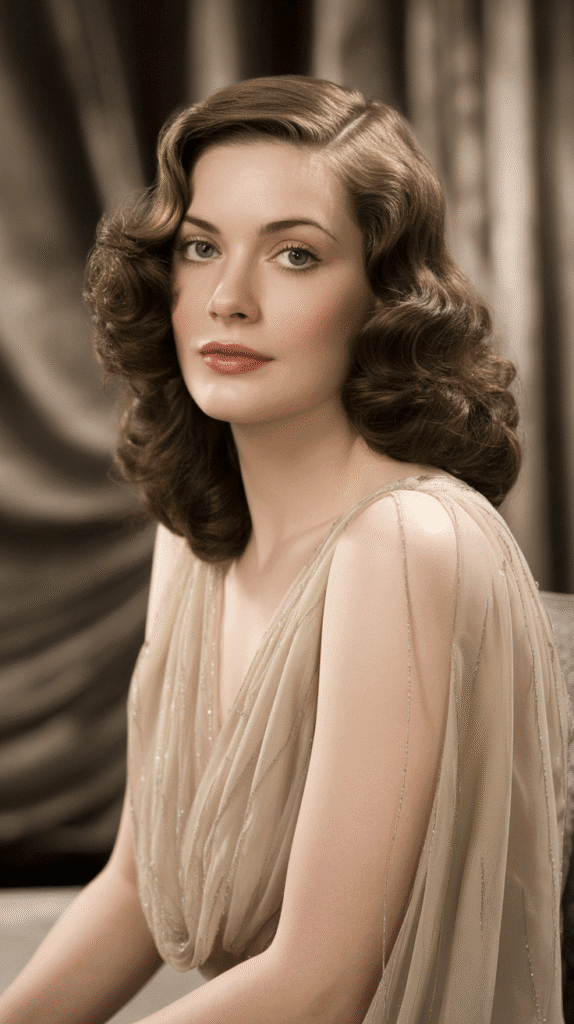
Marcel waves are heat-styled waves created with a Marcel iron or modern curling iron, offering a softer alternative to finger waves with beautiful undulating curves.
Named after French hairdresser Marcel Grateau, this technique was perfected in the 1930s for creating glamorous evening styles.
Preparing Your Hair
- Wash and completely dry your hair, as Marcel waving requires hair to be totally dry unlike finger waving
- Apply a heat protectant spray throughout the hair to prevent damage from high temperatures
- Brush the hair smooth and create your desired part, typically a deep side part for authentic 1930s styling
- Section the hair into manageable portions using clips, starting with the top sections first
Creating the Waves
- Heat a 1-inch barrel curling iron to approximately 300-350°F for fine hair or 350-400°F for thick hair
- Take a 1-2 inch horizontal section of hair near the part line
- Clamp the iron at the roots with the barrel pointing downward at a 45-degree angle
- Rotate the iron a full turn forward to create the first curve, holding for 5-8 seconds
- Release slightly and move the iron down about an inch along the hair strand
- Rotate the iron backward (in the opposite direction) to create the reverse curve
- Continue alternating forward and backward rotations down the entire section of hair
- Allow each waved section to cool completely before touching it to set the pattern
- Work methodically through all sections, ensuring waves align horizontally across the head
- Once all sections are complete and cooled, gently brush through with a soft-bristle brush to blend the waves
- Apply a medium-hold hairspray, scrunching gently to maintain texture while setting the style
3. Sleek Side-Parted Bob
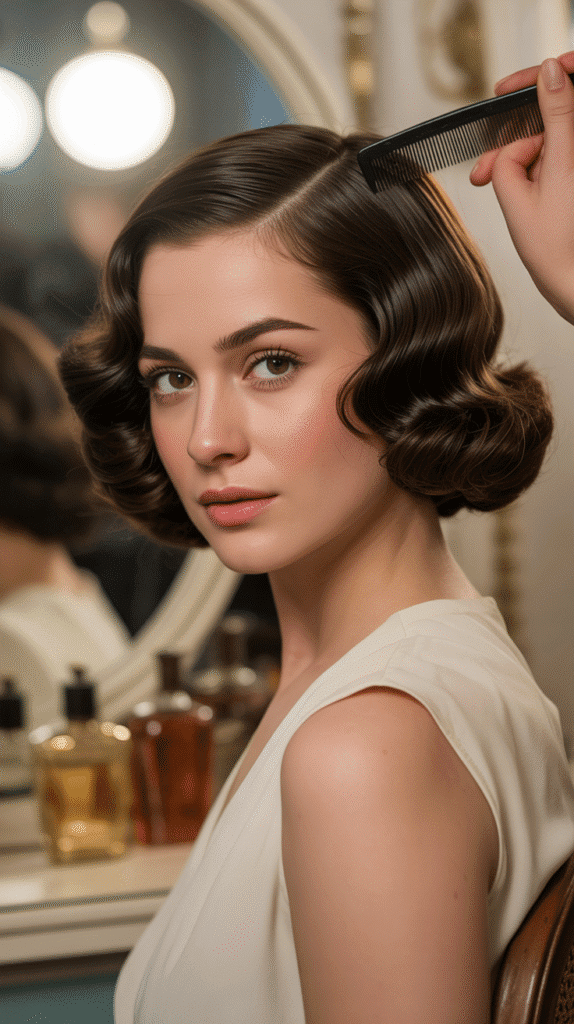
The sleek side-parted bob epitomized sophistication in the 1930s, featuring a dramatic deep side part with hair smoothed close to the head and ending at jaw or chin length.
This minimalist style showcased facial features and was favored by working women and actresses alike.
Achieving the Perfect Part
- Begin with freshly washed, conditioned hair that’s been blown smooth or naturally straight
- Identify your side part placement by drawing an imaginary line from the arch of one eyebrow straight back
- Use the pointed end of a tail comb to create a precise, clean part from front hairline to crown
- Apply smoothing serum or cream to damp hair, focusing on the roots and mid-lengths
Styling the Bob
- Blow-dry the hair in sections using a paddle brush, pulling hair taut for maximum smoothness
- Direct the larger side forward toward the face while smoothing the smaller side behind the ear
- Use a flat iron on low-medium heat to eliminate any remaining texture or wave
- Pass the flat iron slowly from roots to ends, following closely with your other hand to cool the hair
- Apply a small amount of pomade or hair wax to your palms and smooth over the surface
- Pay special attention to the part line, using the comb to ensure it remains razor-sharp
- Tuck the smaller side behind the ear and secure with a bobby pin if needed
- The larger side should drape dramatically across the forehead or cheekbone
- Finish with a light-hold hairspray to maintain the sleek finish without stiffness
- Use a silk or satin scarf at night to preserve the style between washes
4. Pin Curl Set
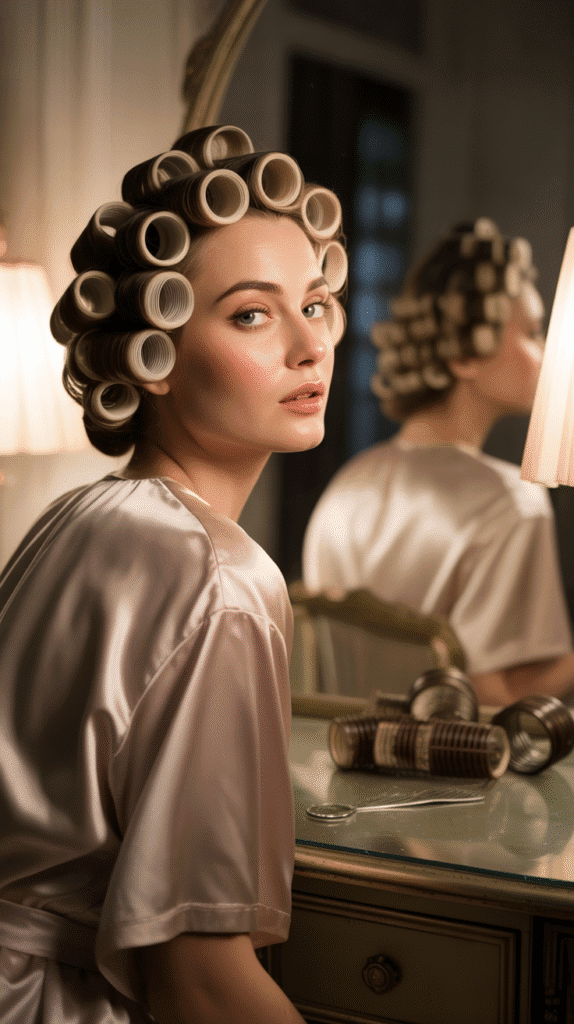
Pin curls formed the foundation of most 1930s hairstyles, creating curls and waves that could be brushed into various elegant styles.
This overnight setting technique was an essential skill for every woman during this era.
Creating Different Pin Curl Patterns
- Understand that clockwise pin curls create volume and lift, while counterclockwise curls create smoothness
- Forward pin curls (curled toward the face) create waves that move forward into the face
- Backward pin curls (curled away from the face) create volume and height at the crown
- Flat pin curls lie flat against the scalp and create smooth waves when brushed out
- Stand-up pin curls have the base lifted and create more defined, bouncy curls
Setting the Curls
- Start with damp, not wet hair, as overly wet hair takes too long to dry and may develop mildew odor
- Apply setting lotion throughout the hair, distributing evenly with a comb
- Divide the hair into 1-inch square sections, working methodically in rows from front to back
- Take one section and comb it smooth, holding it perpendicular to the scalp
- For a flat pin curl, wrap the hair around two fingers close to the scalp in your chosen direction
- Carefully slide the curl off your fingers while maintaining its shape
- Pin the curl flat against the scalp using two bobby pins crossed in an X-pattern
- Continue pinning curls in your chosen pattern, alternating directions to create wave formations
- Cover the head with a silk scarf or hair net to protect the curls while sleeping
- Allow curls to dry completely overnight or use a hood dryer for faster results
- Remove pins carefully in the morning, starting from the nape and working forward
- Brush through gently with a soft bristle brush to blend curls into waves or leave defined for curlier styles
5. Victory Rolls
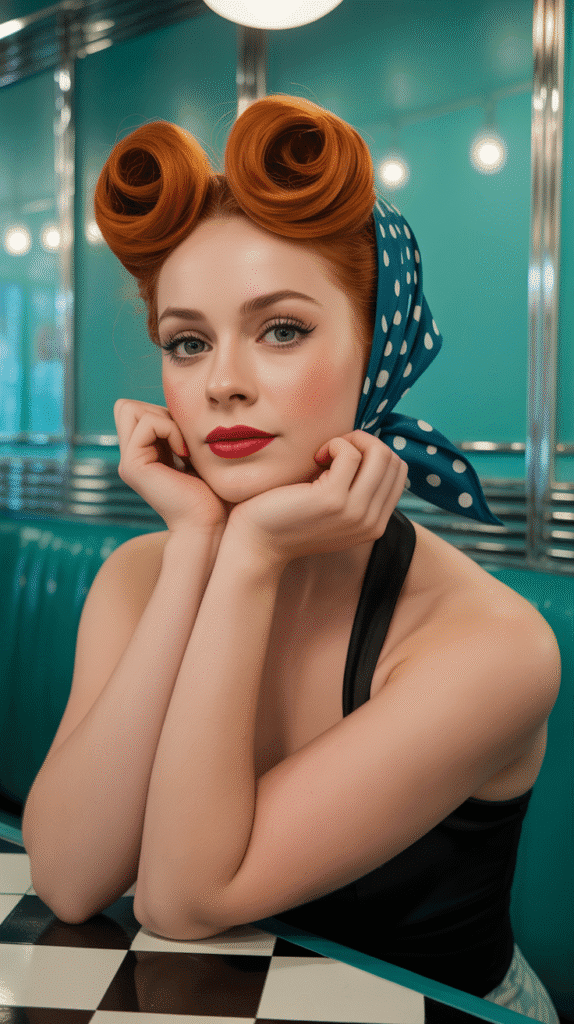
Victory rolls became iconic in the late 1930s and early 1940s, featuring rolled sections of hair at the front of the head that created dramatic height and vintage glamour.
The name supposedly came from the aerial maneuver performed by fighter planes during wartime.
Preparing the Front Sections
- Start with dry hair that has been teased or sprayed with texturizing spray for better grip
- Create a part in the center of the forehead or slightly off-center depending on your preference
- Section off the front portion of hair from the hairline back to approximately the temple area
- Clip away the remaining hair to keep it out of the way while working
- Apply volumizing mousse or light pomade to the front sections for hold and structure
Rolling the Victory Rolls
- Take the front section on one side and backcomb the roots for added volume
- Smooth the surface lightly with a brush while maintaining the underlying volume
- Hold the section up and away from the face at approximately a 45-degree angle
- Begin rolling the hair backward (away from the face) toward the scalp
- Continue rolling until you’ve created a tube-shaped roll that sits on top of the head
- Secure the roll to the head with bobby pins inserted vertically through the roll into the hair beneath
- Add additional pins horizontally along the base of the roll for extra security
- Repeat the exact same process on the opposite side, ensuring both rolls are symmetrical in size and position
- For a variation, create one large central roll instead of two separate rolls
- Spray each completed roll with strong-hold hairspray while holding your hand behind it as a shield
- Style the remaining hair into curls, waves, or a updo as desired
- Finish with an overall mist of hairspray and add vintage accessories like hair flowers or bandanas
6. Low Chignon
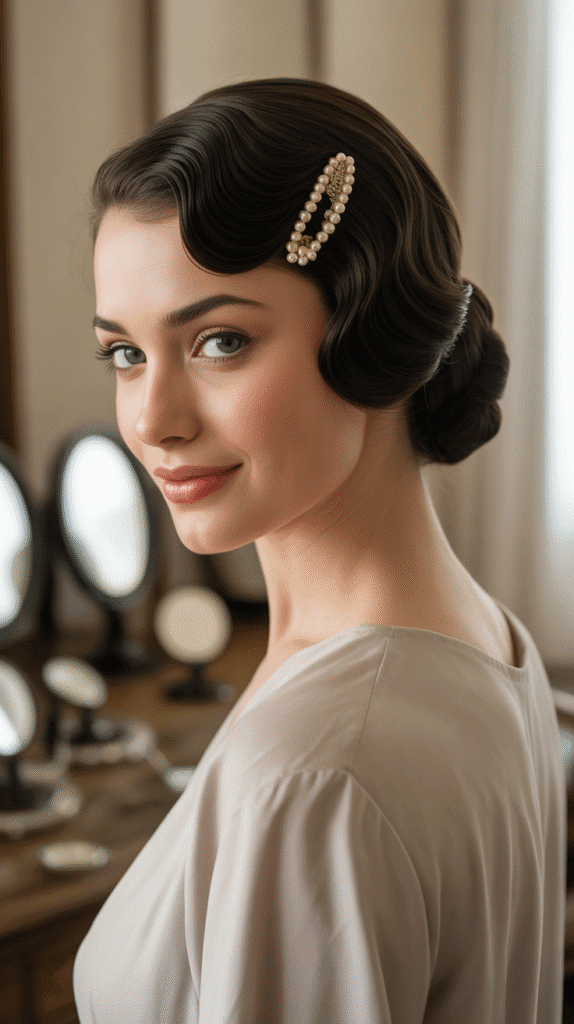
The low chignon represented understated elegance in the 1930s, positioning a smooth roll or twist of hair at the nape of the neck for a sophisticated, refined appearance.
This style was particularly popular for daytime wear and professional settings.
Creating the Foundation
- Begin with hair that has been smoothed straight or set in a pin curl set and brushed through
- Apply smoothing cream throughout the hair to eliminate frizz and flyaways
- Brush all hair back toward the nape, maintaining smoothness on top and sides
- Create your desired part (side or center) and brush each side back smoothly
- Gather all hair at the nape into a low ponytail, positioning it just above the hairline
- Secure with an elastic that matches your hair color
Forming the Chignon
- Divide the ponytail into two equal sections
- Twist both sections individually in the same direction until they form rope-like coils
- Wrap the two twisted sections around each other, continuing until you reach the ends
- Coil the twisted rope into a circular shape at the nape, creating a flat bun
- Tuck the ends underneath the chignon and secure with bobby pins inserted horizontally
- Add bobby pins around the perimeter of the chignon, spacing them about an inch apart
- For a sleeker variation, don’t twist the hair but simply wrap the ponytail around itself
- Use a hair net in a matching color over the chignon for added security and smoothness
- Smooth any loose hairs at the hairline with pomade and a fine-tooth comb
- Set the style with a light mist of hairspray, focusing on the smooth top sections
7. Faux Bob with Long Hair
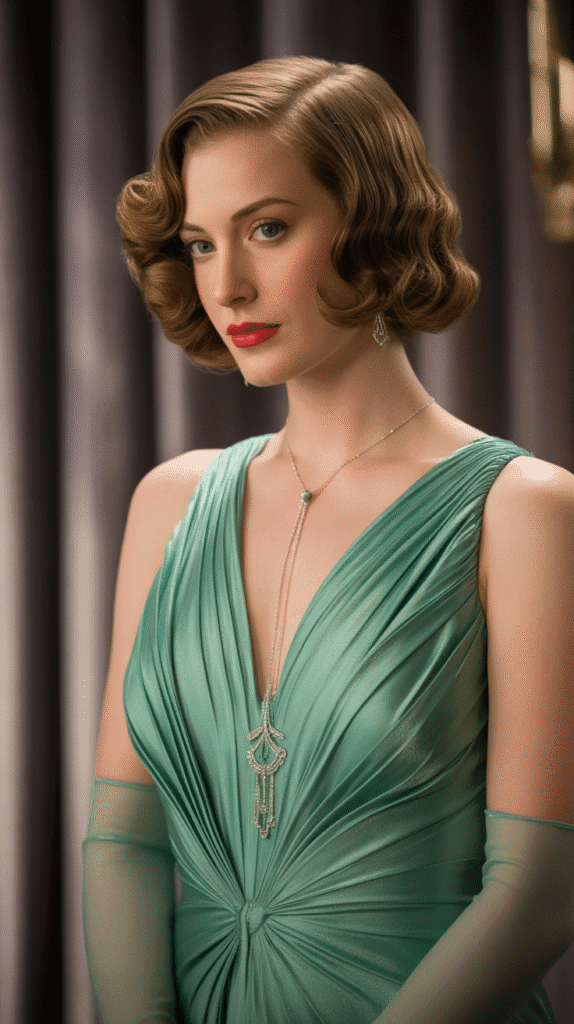
The faux bob technique allowed women with long hair to achieve the fashionable short bob appearance without cutting their hair, a clever styling trick that remained popular throughout the 1930s.
This versatile style could be adjusted for both daytime simplicity and evening glamour.
Tucking and Securing Long Hair
- Start with hair set in pin curls or waves for authentic 1930s texture
- Create a deep side part and style finger waves on the top sections if desired
- Gather the hair at the nape into a low ponytail, keeping the top sections smooth
- Fold the ponytail upward toward the crown, creating a loop of hair
- Pin the loop securely to the back of the head using multiple bobby pins
- Take the remaining length and fold it under again, creating another loop
- Continue folding and pinning until all length is secured and hidden beneath
- The final tuck should create the illusion of a bob that ends at chin or jaw level
Creating the Bob Illusion
- Carefully arrange the top layer of hair over the tucked sections to conceal them
- Use your fingers to gently shape the “bob” silhouette, adjusting the sides to appear even
- Pin any visible longer pieces underneath the bob shape, tucking ends inward
- Check the profile view in a mirror to ensure no tucked sections are visible from the side
- Apply pomade to smooth the surface and create authentic 1930s sheen
- Use small amounts of hairspray on flyaways, but avoid over-spraying which can reveal the illusion
- Add a vintage hair clip or barrette on the larger side of the part for decoration and security
- For evening variations, create curls at the bottom edge of the faux bob for a more voluminous finish
8. Rolled Bangs
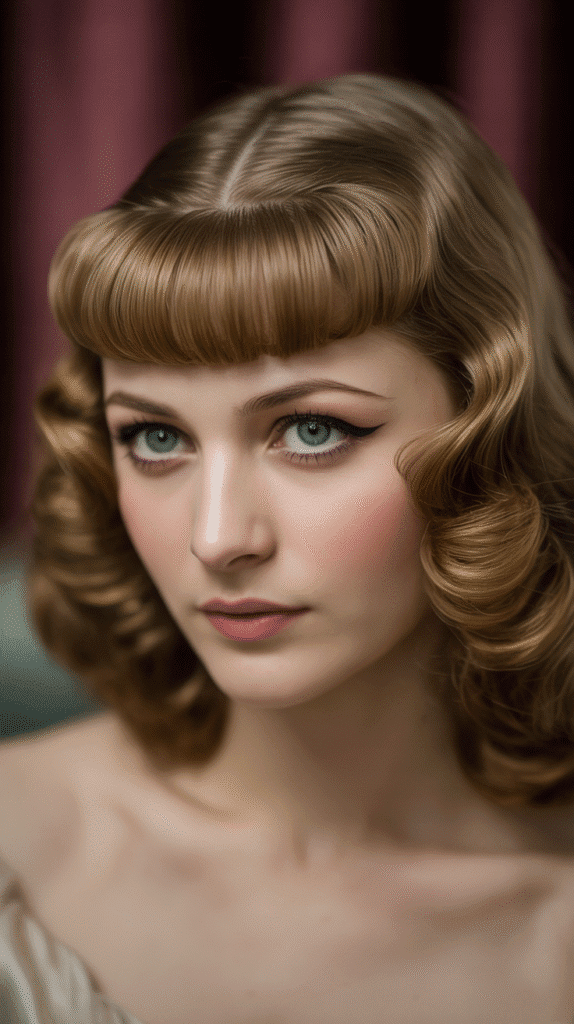
Rolled bangs featured the front section of hair rolled upward and backward into a smooth cylindrical shape across the forehead, creating height and a distinctly vintage silhouette.
This style element appeared in countless variations throughout the 1930s.
Sectioning the Bangs
- Separate the front section of hair from ear to ear, creating a horseshoe-shaped section about 2-3 inches deep
- Clip the remaining hair away to keep it separate from the bangs section
- Apply setting lotion or volumizing mousse to the bang section
- Comb the bangs forward and slightly upward from the roots
Creating the Roll
- Take a hair rat (cylindrical foam padding) or rolled-up tissue paper the width of your forehead
- Position the hair rat horizontally across your forehead at the hairline
- Drape the bang section over the hair rat, covering it completely
- Begin rolling the hair rat backward toward the crown, rolling the hair with it
- Continue rolling until the roll sits on top of the head where the bang section originally started
- Secure the roll in place with bobby pins inserted at an angle through the roll into the scalp
- Add pins on both ends of the roll and at intervals along its length
- Smooth any irregularities in the roll’s surface with your fingers
- Spray the roll with firm-hold hairspray to maintain its shape throughout the day
- For a no-rat variation, backcomb the bang section heavily before rolling it backward and pinning
- Style the remaining hair as desired, ensuring it complements the rolled bang section
9. Deep Wave Bob
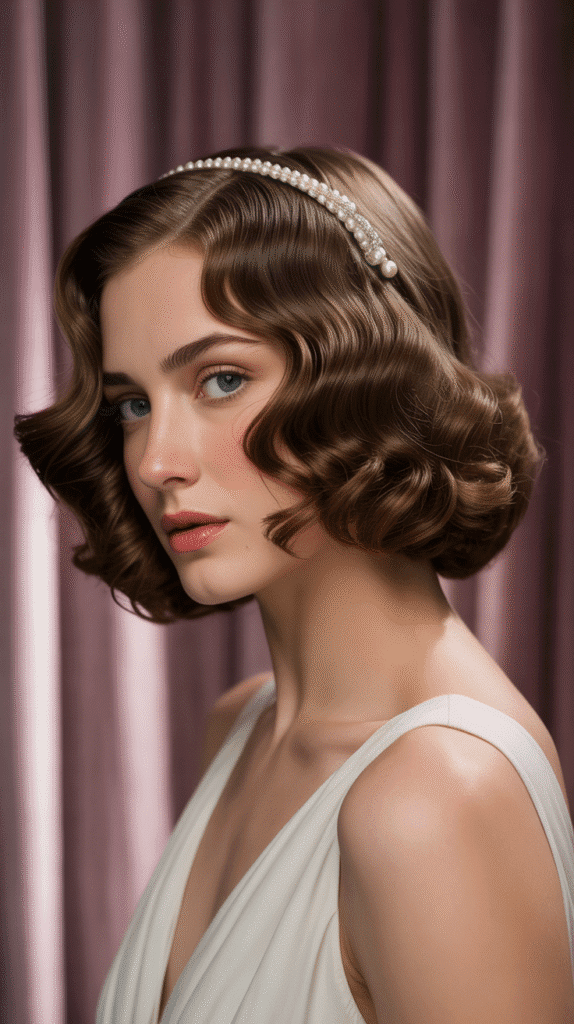
The deep wave bob featured exaggerated S-shaped waves throughout a bob-length cut, creating a dramatic sculptural effect that exemplified 1930s sophistication.
This style combined the short bob silhouette with the decade’s signature wave technique.
Setting the Deep Waves
- Begin with a bob haircut that falls between chin and shoulder length
- Wash and condition the hair, then towel dry until damp but not dripping
- Apply abundant wave-setting lotion, working it through from roots to ends with a comb
- Create a deep side part, positioning it above the arch of one eyebrow
- Section the larger side into horizontal layers, each about 1-2 inches wide
Forming Exaggerated Waves
- Starting at the top layer near the part, place your index finger at the hairline
- Push a deep ridge of hair forward, creating an exaggerated C-curve
- Secure this first crest with a wave clip positioned perpendicular to the wave direction
- Move down 1.5-2 inches (wider than standard finger waves) and push the hair backward
- Clip this trough section with another wave clip
- Continue alternating forward and backward curves, creating wider, more dramatic waves than typical finger waves
- Each wave should be approximately 1.5-2 inches wide from crest to crest
- Repeat the process on the smaller side of the part, mirroring the wave pattern
- For the back sections, continue the wave pattern or opt for softer pin curls that will blend when brushed
- Place a hair net over the entire style and sit under a hood dryer for 45-60 minutes
- Allow the hair to cool completely while still clipped before removing any clips
- Remove clips carefully from bottom to top, then gently loosen the waves with your fingers
- Apply shine serum and hairspray for a glossy, set finish
10. Pageboy Cut
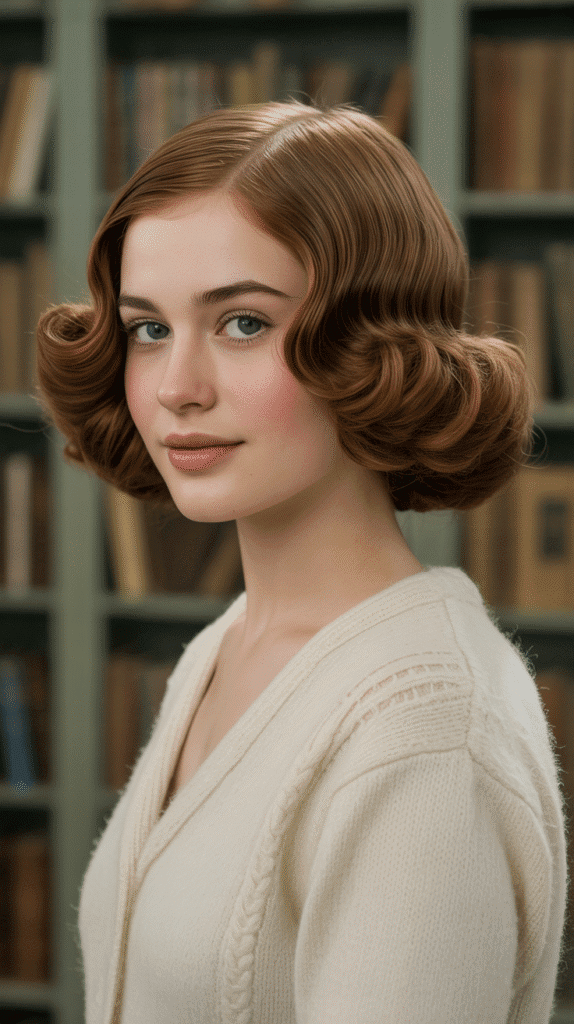
The pageboy featured hair curled under at the ends in a uniform roll that created a rounded silhouette, becoming increasingly popular in the late 1930s as a youthful, approachable style.
The cut typically ranged from jaw-length to shoulder-length.
Cutting and Preparing
- For those cutting their hair, request a blunt cut at the desired length with no layers for authentic pageboy shape
- The cut should create a straight line around the head when viewed from behind
- Ensure hair is all one length from front to back on each side
- Wash and apply volumizing mousse or setting lotion to damp hair
Setting the Under-Curl
- Divide the hair into 2-inch horizontal sections starting from the nape
- For a wet set, take each section and wrap it around a large roller (1.5-2 inches in diameter)
- Roll the hair under and toward the scalp, ensuring the ends are smoothly wrapped
- Secure each roller with a pin or clip and continue up to the crown
- For the top sections, roll backward (under) to maintain the consistent curl direction
- Dry thoroughly under a hood dryer or allow to air dry for several hours
- Alternatively, use a large-barrel curling iron on dry hair for faster results
- Take 2-inch sections and clamp the iron near the ends
- Roll the iron under toward the scalp, holding for 8-10 seconds
- Release and allow each section to cool before touching
- Once all sections are curled, brush through with a paddle brush to blend
- The brush-out should create one continuous under-curl around the entire perimeter
- Use your hands to shape the rounded silhouette, ensuring uniform curve all around
- Finish with medium-hold hairspray to maintain the under-curl without stiffness
11. Pompadour Style
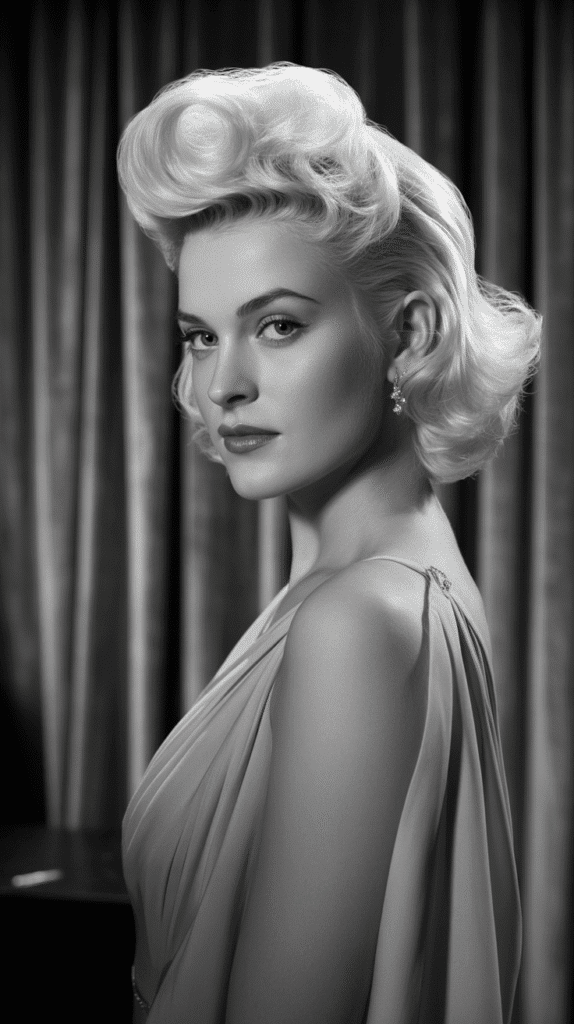
The pompadour in 1930s women’s styling featured height at the front of the head, with hair swept upward and backward before transitioning into waves or a updo.
This dramatic style created a glamorous, statuesque appearance favored for evening occasions.
Building Height and Volume
- Section off the front portion of hair from the hairline back approximately 3-4 inches
- Clip away the sides and back sections
- Apply volumizing powder or backcomb the front section heavily at the roots
- Smooth the surface of the backcombed section lightly with a brush, maintaining the volume underneath
- Gather the front section and hold it straight up from the head
Shaping the Pompadour
- Determine your desired height (typically 2-4 inches above the natural hairline for 1930s style)
- Fold the front section backward, creating a smooth roll that sits on top of the backcombed volume
- Pin the pompadour to the head where it meets the crown area using crisscrossed bobby pins
- Add additional pins horizontally along the base to secure the volume
- For extra height, place a small hair rat or rolled tissue at the front before folding the hair over it
- Smooth any irregularities on the surface with a fine-tooth comb and pomade
- Unclip the side sections and comb them backward, blending into the pompadour
- Pin the sides smoothly, ensuring they transition seamlessly into the pompadour structure
- Style the remaining hair into waves, curls, or a low updo depending on your preference
- Apply firm-hold hairspray to the pompadour, holding your hand behind it as a barrier
- Add a decorative hair comb or jeweled clip at the base of the pompadour for extra glamour
12. Halo Braid
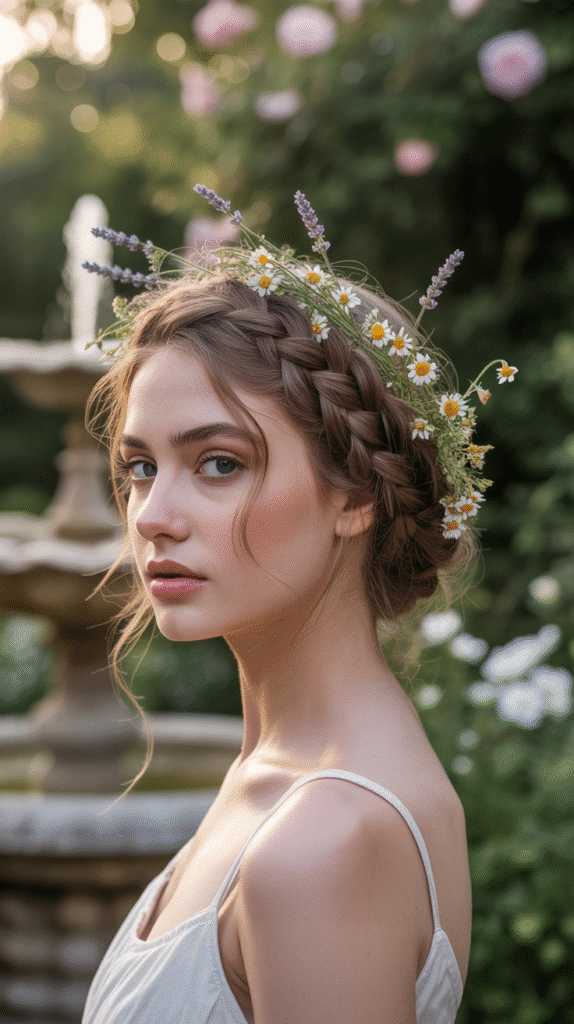
The halo braid created a crown-like effect with braided hair wrapped around the head, popular in the 1930s as both a practical daytime style and an elegant evening option when adorned with accessories.
This style worked particularly well for women with longer hair.
Creating the Foundation Braids
- Start with hair that has been set with waves or curls for authentic 1930s texture
- Create a deep side part or center part depending on your preference
- Brush one side of the hair smooth and gather it at the nape behind the ear
- Divide this section into three equal strands and begin a standard three-strand braid
- Braid loosely for a softer, more romantic appearance characteristic of the era
- Secure the end with a small elastic and repeat on the opposite side
Forming the Halo
- Take one braid and bring it across the top of the head following the hairline
- Position it approximately 1-2 inches back from the hairline, not directly on it
- Pin the braid in place with bobby pins every 2 inches, hiding them underneath the braid
- Continue pinning until the braid reaches the opposite side of the head
- Take the second braid and wrap it around the back of the head at the nape level
- Bring this braid up to meet the first braid, creating a complete circle
- Tuck the ends of both braids underneath each other, creating a seamless join
- Secure all connection points with multiple bobby pins for stability
- Gently pull on the outer edges of the braids to widen them slightly, creating a fuller halo effect
- For 1930s authenticity, don’t pull too much—the style should appear neat rather than messy
- Weave fresh flowers, ribbon, or vintage hair jewelry through the braids for special occasions
- Set with light hairspray to maintain the style while preserving some natural movement
13. Curly Bob with Deep Side Part
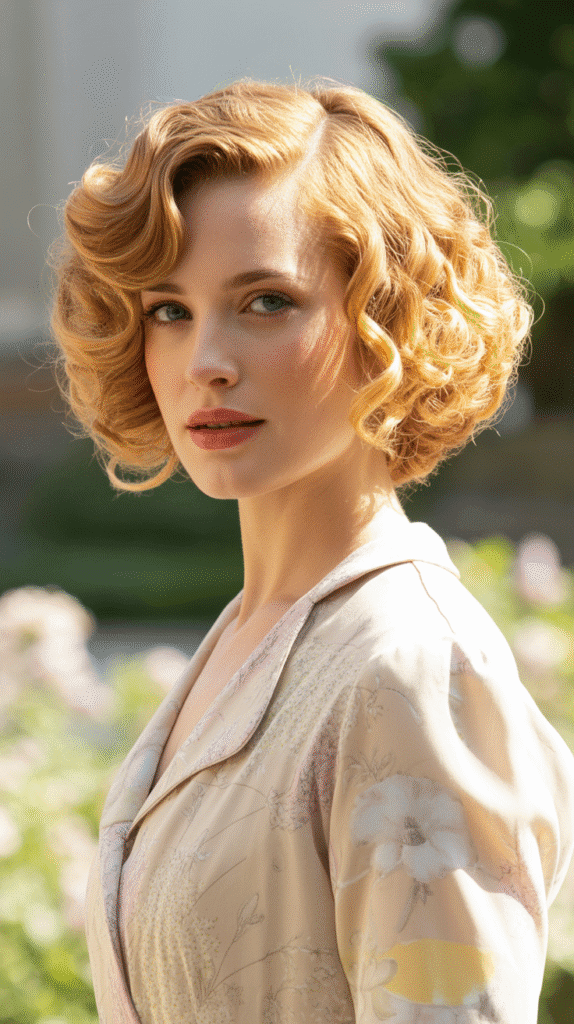
The curly bob with deep side part combined the short bob silhouette with full, bouncy curls and a dramatic off-center part, creating a playful yet sophisticated look.
This style showcased the natural texture that many women enhanced with permanent waves during the 1930s.
Preparing and Parting
- Begin with clean, dry hair that naturally has curl or has been set with pin curls
- Create an extreme side part, positioning it directly above one eyebrow’s arch
- Use the pointed end of a tail comb to make the part razor-sharp and precise
- Apply curl-enhancing cream throughout the hair, scrunching it into the curls
Defining and Arranging Curls
- Section the hair into four quadrants: larger side top, smaller side top, and two back sections
- Working with one 1-inch section at a time, wrap the hair around a small to medium curling iron
- For the larger side of the part, curl all sections toward the face for a dramatic sweep
- For the smaller side, curl sections backward away from the face
- On the back sections, alternate curl directions for natural-looking fullness
- Hold each curl for 8-10 seconds, then release into your hand and allow to cool
- Once all sections are curled and cooled, flip your head upside down and shake gently
- Use your fingers to separate larger curls into smaller ringlets, creating more volume
- Arrange the larger side to sweep dramatically across the forehead and cheekbone
- Pin the smaller side behind the ear, either smooth or with small curls visible
- Apply a small amount of hair oil to your palms and scrunch into curls for shine and definition
- Finish with a flexible-hold hairspray to maintain curl shape without crunchiness
14. Braided Crown
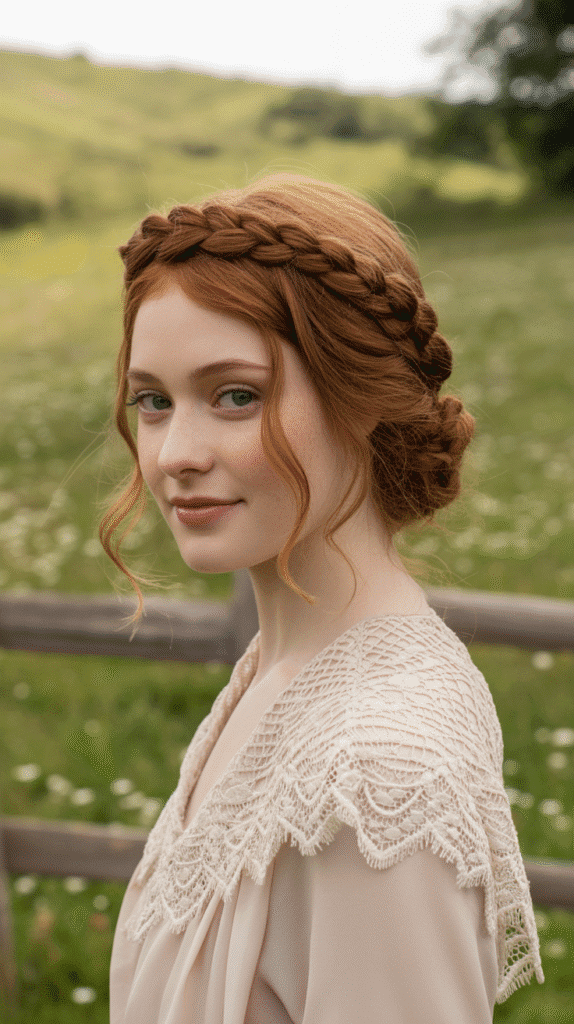
The braided crown featured braids wrapped around the head like a coronet, with the remaining hair styled in waves or curls below.
This romantic style was particularly popular for garden parties and summer occasions in the 1930s.
Sectioning for the Crown
- Create a horizontal part from ear to ear across the top of the head, about 3 inches back from the hairline
- Clip away the hair below this part, leaving it for later styling
- Divide the top section into two equal parts with a center or side part
Creating the Crown Braids
- Starting on one side at the part, begin a Dutch braid (reverse French braid) along the hairline
- Take three small sections and begin braiding with the middle strand going under rather than over
- Add small sections of hair from the hairline to the braid as you work toward the ear
- Continue the Dutch braid following the curve of the head from front to back
- When you reach behind the ear, stop adding new sections and complete as a regular three-strand braid
- Secure temporarily with a small elastic
- Repeat the exact process on the opposite side, ensuring both braids are symmetrical
- Take the first braid and wrap it across the top of the head like a headband
- Pin it securely with bobby pins every inch, tucking the end underneath the opposite braid
- Take the second braid and position it behind the first, creating a double-braided crown effect
- Alternatively, crisscross the braids for a more intricate appearance
- Secure all ends by tucking them underneath the braids and pinning invisibly
- Release the bottom section of hair and style into soft waves or curls using your preferred method
- The finished look should feature a braided crown with romantic curls or waves cascading below
15. Asymmetrical Waves
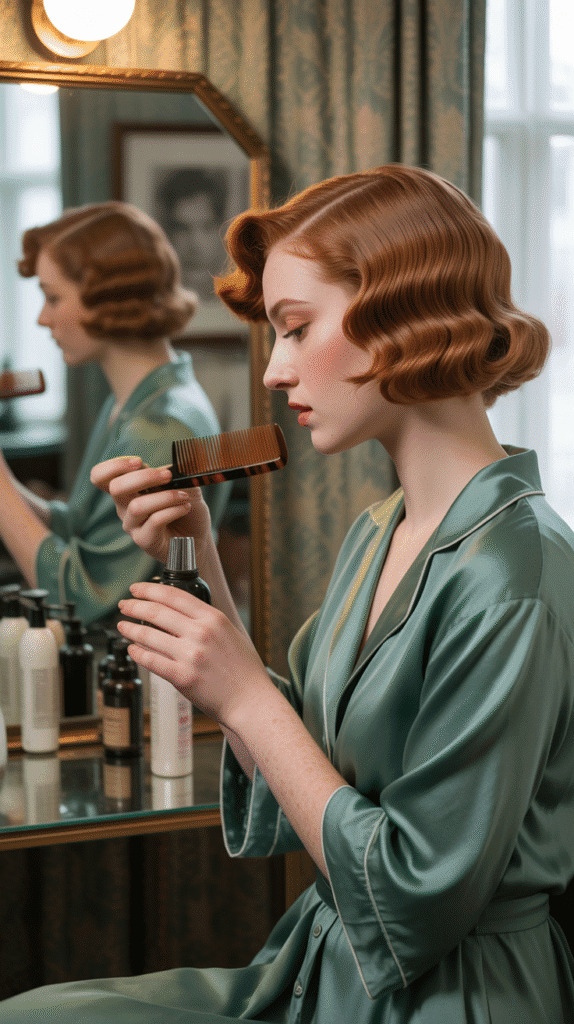
Asymmetrical waves featured an off-center part with dramatically different wave patterns on each side, creating visual interest through intentional imbalance.
This artistic approach to finger waving showcased advanced styling skill and was favored for artistic or theatrical presentations.
Planning the Asymmetry
- Create a deep side part positioned as far to one side as possible
- Decide which side will feature larger, looser waves and which will have tighter, more numerous waves
- Apply setting lotion throughout damp hair and comb smooth
Creating Contrasting Patterns
- On the larger side, create finger waves spaced 2-3 inches apart for dramatic S-curves
- Use the standard finger wave technique but allow more hair between each crest and trough
- Secure these large waves with wave clips and allow them to create bold, sculptural shapes
- On the smaller side, create tighter waves spaced only 1 inch apart
- These closer waves will create a denser, more textured appearance
- Use smaller clips for the tighter waves to maintain their compressed pattern
- For the back sections, transition gradually between the two patterns
- Start with the tighter pattern from the smaller side and gradually space waves wider as you approach the larger side
- This creates a gradient effect rather than an abrupt change
- Allow hair to dry completely, whether under a dryer or air drying
- Remove clips carefully, appreciating the intentional contrast between sides
- Apply pomade to enhance shine and emphasize the different wave depths
- This style requires confidence to wear as the intentional asymmetry is a bold statement
16. Gibson Tuck
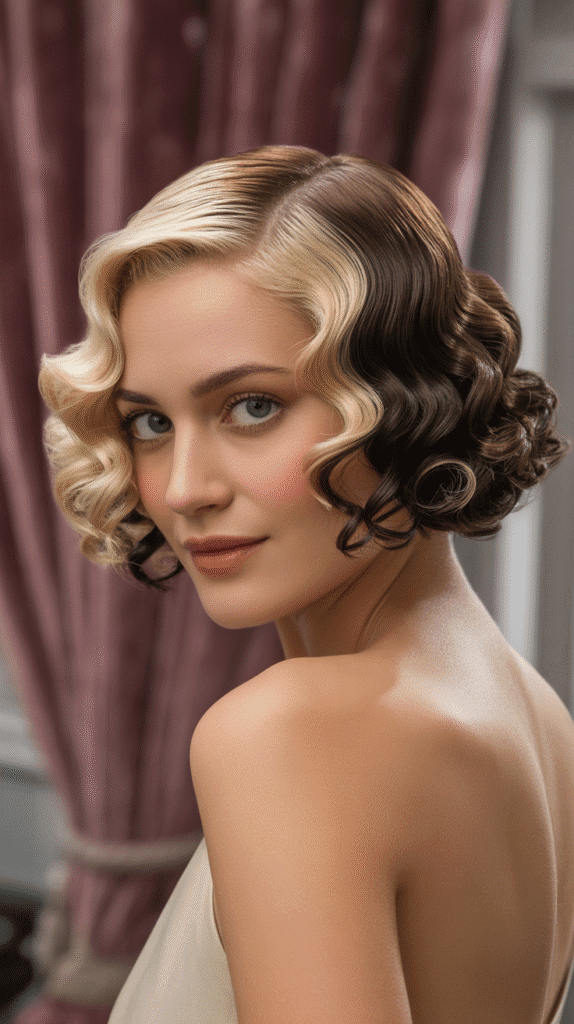
The Gibson tuck featured hair loosely rolled and tucked under at the nape, creating a soft, romantic silhouette named after Gibson Girl illustrations from earlier decades but adapted for 1930s sensibilities.
This style worked beautifully for medium to long hair.
Creating Soft Waves
- Begin with hair set in large, loose pin curls or hot-rolled for soft wave texture
- Brush through the curls gently to create waves rather than defined ringlets
- Create a side or center part according to your preference
- Leave face-framing sections loose at the temples for romantic tendrils
Forming the Tuck
- Gather all hair (except face-framing pieces) loosely at the nape without pulling too tightly
- Don’t use an elastic—the Gibson tuck should be soft and loose
- Hold the gathered hair with one hand and twist very loosely
- Roll the twisted hair upward toward the crown, forming a loose horizontal roll
- Stop rolling when the roll sits at approximately mid-head height
- Tuck the ends of the hair underneath the roll, hiding them from view
- Secure the roll with bobby pins inserted horizontally through the roll into the hair beneath
- Add pins every 2 inches along the length of the roll, but don’t over-pin
- Gently pull and loosen sections of the roll to create a fuller, softer appearance
- Allow some texture and slight irregularity for authentic romantic character
- Take the face-framing tendrils and curl them loosely with a curling iron if desired
- Leave a few small wisps loose at the nape for added softness
- Use minimal hairspray to maintain the intentionally loose, romantic aesthetic
17. Finger Wave Bob with Curled Ends
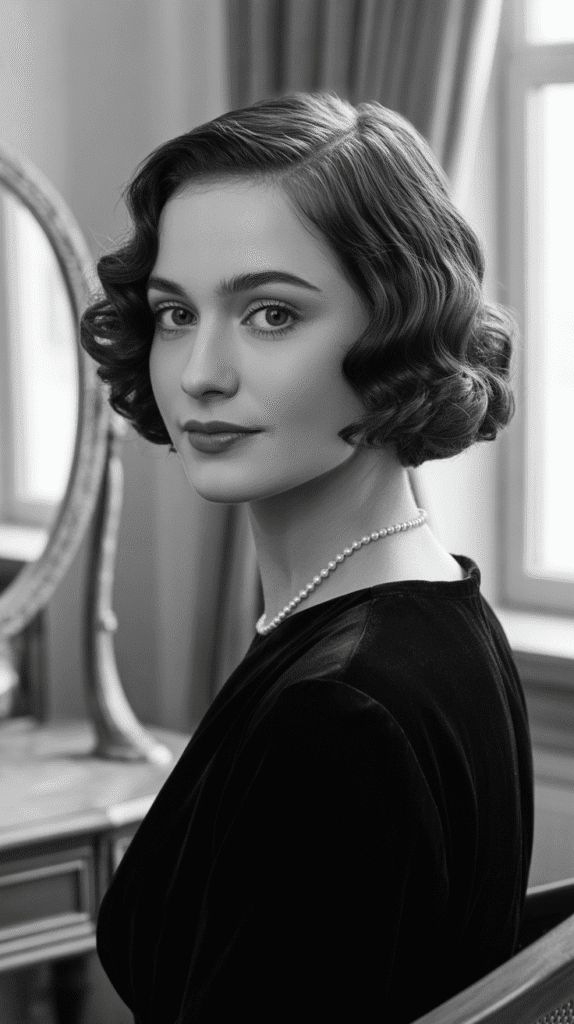
This hybrid style combined the sculptural beauty of finger waves on top with curled ends at the bob length, creating dimension and movement.
The contrasting textures made this an especially dynamic and eye-catching 1930s look.
- Start with clean, damp hair cut in a bob that falls between chin and shoulder length
- Apply strong-hold wave-setting lotion to the top sections from roots to approximately ear level
- Create a deep side part using a fine-tooth comb
- Form finger waves in the top sections using the classic S-curve technique described earlier
- Space the waves approximately 1-1.5 inches apart for balanced proportion
- Secure each wave crest and trough with metal wave clips
- Work the finger waves from the front hairline back to the crown area
- Continue the wave pattern on both sides of the head, keeping them symmetrical
Creating the Curled Ends
- Once finger waves are clipped in place, focus on the bottom 3-4 inches of hair at the perimeter
- Apply pin curl setting lotion to these end sections
- Create flat pin curls with the bottom sections, alternating curl directions
- For outward flipping ends, curl the sections away from the face
- For inward rolling ends, curl the sections toward the face for a more classic look
- Pin each curl securely and allow the entire style to dry completely under a hood dryer
- Once dry, carefully remove wave clips from the top sections first
- Then remove the pins from the curled ends
- Gently brush through the bottom curls with a soft bristle brush to create uniform curved ends
- Leave the finger waves untouched on top for maximum definition
- The contrast between the structured waves and soft curls creates beautiful dimension
- Apply shine spray and light-hold hairspray to finish the style
18. Side-Swept Curls
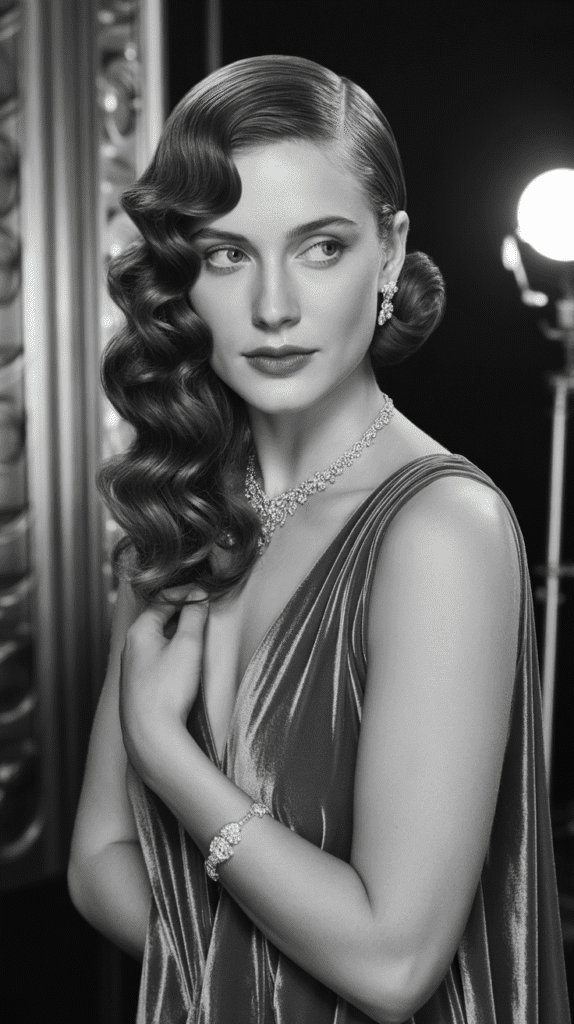
Side-swept curls featured all the hair dramatically brushed to one side, creating an asymmetrical cascade of curls that exemplified Hollywood glamour.
This red-carpet style was immortalized by countless starlets attending premieres and formal events.
Preparing the Curls
- Begin with hair set in pin curls throughout or curled with a curling iron
- Create curls of varying sizes (from 1-inch to 2-inch sections) for natural dimension
- Allow all curls to cool completely if using heat styling
- Apply a light styling cream to add definition without weighing down the curls
Sweeping and Arranging
- Create a deep side part, positioning it far to one side above the eyebrow
- On the smaller side of the part, brush hair tightly against the head
- Apply gel or pomade to this side for sleek control
- Secure the smaller side behind the ear with bobby pins placed in a vertical line
- Take all the curls from the larger side and bring them forward over one shoulder
- Arrange the curls in an organized cascade, with larger curls forming the outer structure
- Place smaller, tighter curls throughout for texture and fullness
- Pin sections strategically behind the ear and at the temple to keep the sweep in place
- The curls should create a diagonal flow from the part line down across the chest
- Leave some curls unpinned at the bottom to move freely for romantic effect
- Apply hairspray in sections, lifting curls and spraying underneath for lasting hold
- Add a jeweled hair clip or vintage brooch at the point where curls are gathered behind the ear
19. Barrel Curls
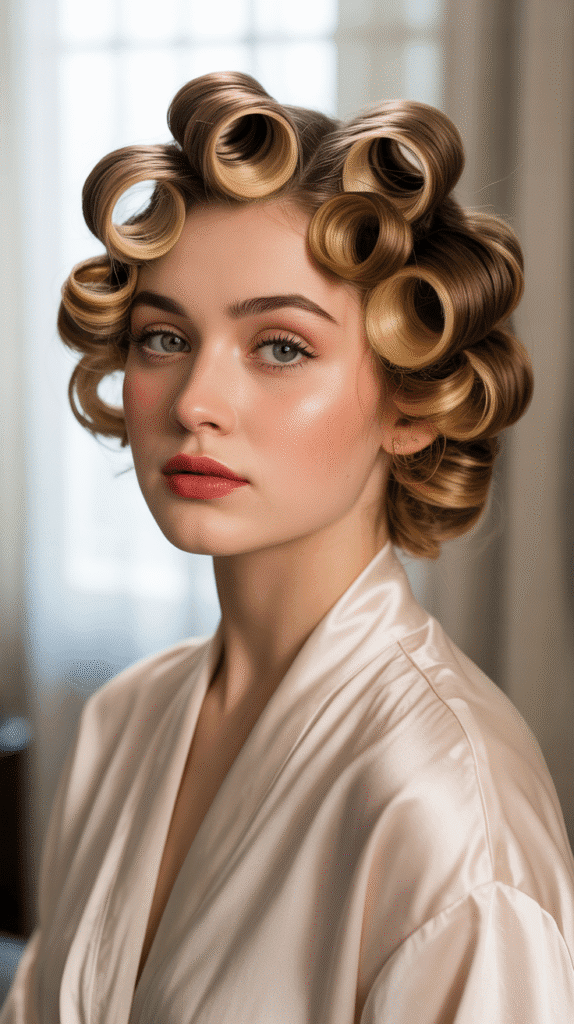
Barrel curls were large, structured curls formed around large rollers that created uniform cylindrical shapes throughout the hair.
These bold curls were particularly fashionable in the late 1930s and transitioned into 1940s styling.
Setting Large Rollers
- Start with clean, damp hair with setting lotion applied throughout
- Divide hair into sections approximately 2-3 inches square
- Use large rollers (1.5-2.5 inches in diameter) for authentic barrel curl size
- Take one section and comb it smooth, holding it perpendicular to the scalp
- Place the roller at the ends of the hair and distribute hair evenly across the roller’s width
Creating Uniform Curls
- Roll the hair smoothly around the roller, keeping even tension throughout
- Roll toward the scalp, ensuring hair doesn’t bunch or twist
- Secure the roller with a pin or clip once it sits against the scalp
- Continue placing rollers in neat rows from the front hairline to the nape
- For the top sections, roll backward away from the face
- For side sections, roll vertically toward the top of the head
- For back sections, roll under and toward the nape
- The direction of rolling determines the final curl direction and volume
- Dry hair completely under a hood dryer for 45-60 minutes
- Allow hair to cool completely before removing any rollers to ensure curls set properly
- Remove rollers carefully, sliding them out without disturbing the curl structure
- Each curl should maintain its barrel shape initially
- For structured style, leave curls as is and arrange them with pins
- For softer style, gently brush through to blend curls into waves
- Apply medium-hold hairspray to maintain the curl formation
20. Rolled Updo
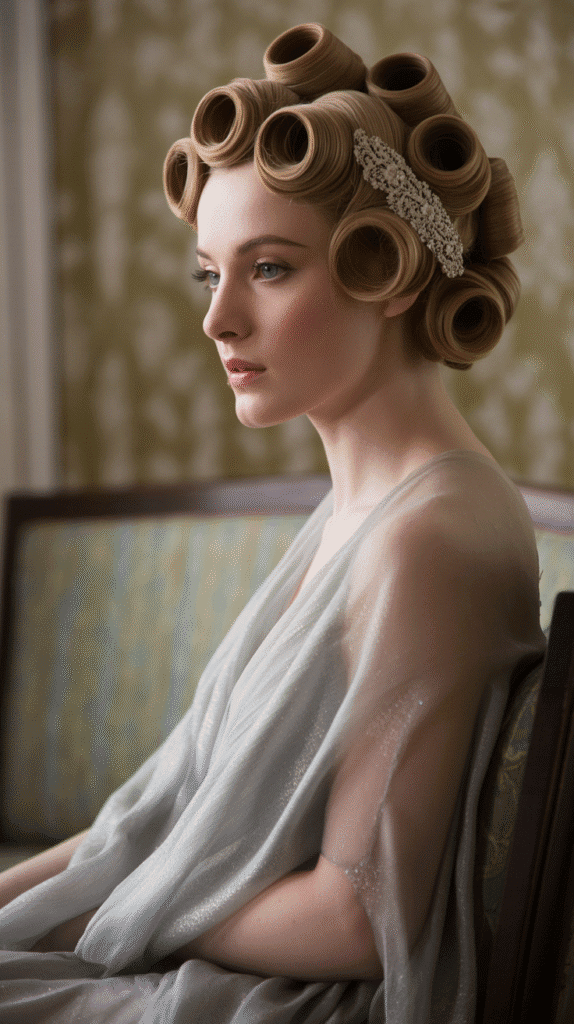
The rolled updo featured sections of hair rolled and pinned in various directions to create an elegant, sculptural updo perfect for formal occasions.
This sophisticated style showcased the hair’s texture while keeping it completely off the neck and shoulders.
Creating Foundation Rolls
- Start with hair that has been set with waves or curls for texture and grip
- Brush through the set to create soft, blended waves
- Create a side or center part according to your preference
- Section the front portion from temple to temple, about 2-3 inches deep
- Clip this section away temporarily
Building the Updo Structure
- Take a horizontal section from ear to ear at the crown level
- Backcomb this section lightly at the roots for volume
- Smooth the surface and roll the section backward toward the crown
- Pin the roll in place with bobby pins inserted vertically through the roll
- Take the next section below and repeat the rolling and pinning process
- Each roll should sit slightly lower than the one above it
- Continue this process with horizontal sections until you reach the nape
- Gather the hair at the nape and roll it upward into a vertical roll
- Secure this nape roll with pins, tucking the ends underneath invisibly
- Return to the front section and divide it into two or three parts
- Roll each front section backward or to the side, creating decorative rolls that frame the face
- Pin these rolls securely, positioning them artistically around the updo
- For added dimension, create some rolls that are tighter and others that are looser
- Insert a decorative vintage hair comb or jeweled pins for embellishment
- Finish with firm-hold hairspray to ensure the updo lasts throughout the evening
21. Flat Pin Curl Hairstyle
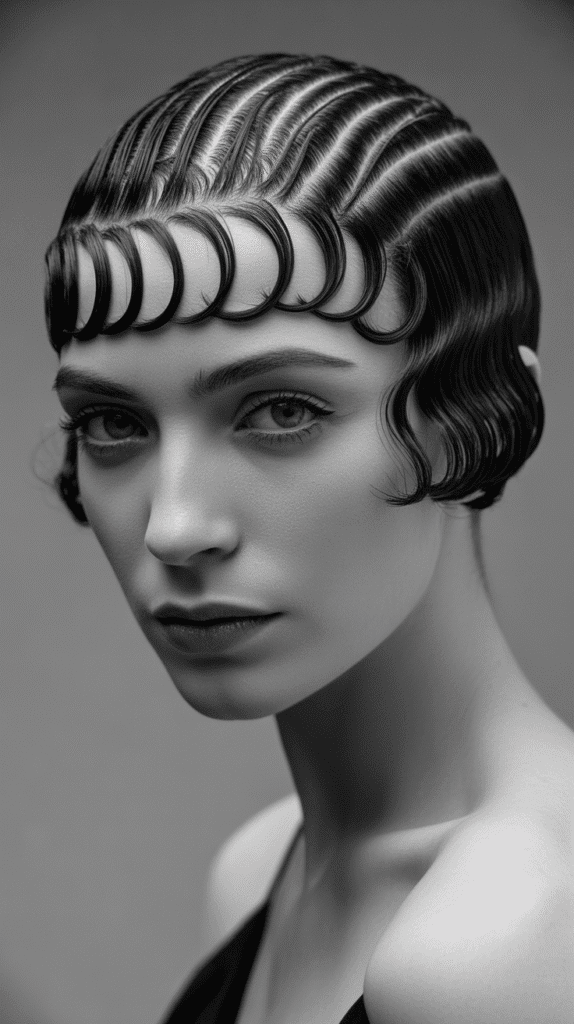
The flat pin curl hairstyle showcased pin curls left visible as the finished style rather than being brushed out, creating a sculptural, geometric appearance.
This artistic style was popular for editorial photography and fashion-forward individuals.
Creating the Pattern
- Start with damp hair with setting lotion applied throughout
- Plan your curl pattern by deciding whether to create horizontal rows, vertical columns, or diagonal lines
- Mark imaginary grid lines on the head to guide curl placement
- Begin at the front hairline and work backward in organized sections
Forming Visible Pin Curls
- Take a 1-inch square section of hair and comb smooth
- Wind the hair around two fingers close to the scalp, creating a flat disk shape
- Ensure the curl lies completely flat against the head with no lifted areas
- Secure with two bobby pins crossed in an X pattern through the center of the curl
- For varied visual interest, alternate curl directions in checkerboard pattern
- Create some curls winding clockwise and others counterclockwise for textured effect
- Keep all curls uniform in size for a polished, intentional appearance
- Continue pinning curls in neat, organized rows until the entire head is covered
- Pay special attention to spacing, keeping curls close together without overlapping
- Allow hair to dry completely under a hood dryer or overnight
- This style is unique because you remove pins but DO NOT brush out the curls
- Carefully remove each pin, leaving the curl shape completely intact
- Gently arrange and position curls for aesthetic appeal
- Apply significant hairspray to set the curls and prevent them from dropping
- This bold style makes a dramatic statement and showcases technical skill
22. Tiered Wave Bob
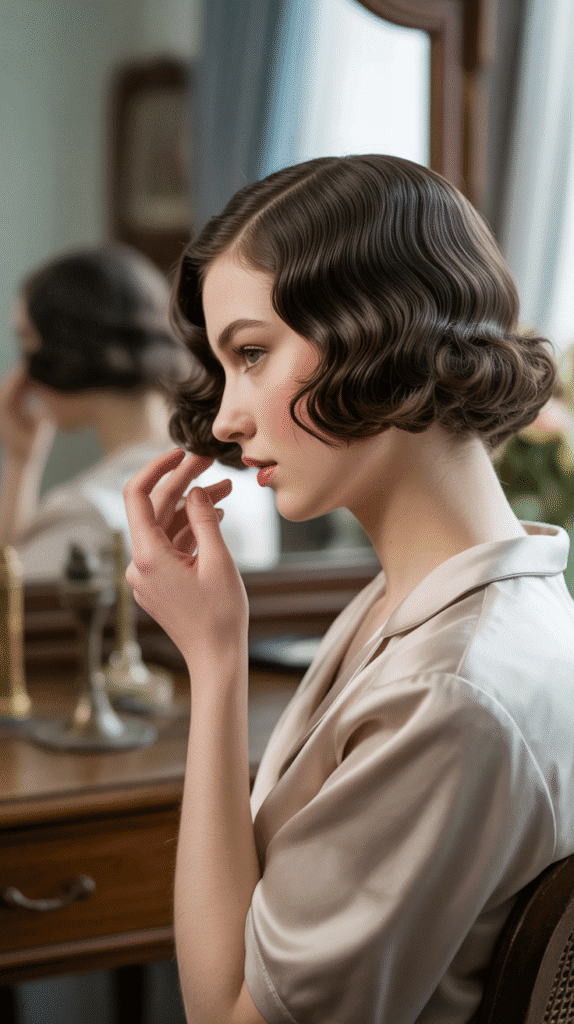
The tiered wave bob featured multiple horizontal layers of waves stacked on top of each other, creating a sculptural, architectural effect.
This advanced technique demonstrated mastery of finger waving and was reserved for special occasions.
Sectioning for Tiers
- Begin with chin-length bob cut in one length
- Apply generous setting lotion to damp hair
- Divide hair into three horizontal tiers: top (hairline to temple), middle (temple to ear top), bottom (ear level to ends)
- Work on one tier at a time, clipping away the others
Creating Stacked Waves
- Start with the top tier and create finger waves using the standard technique
- Make these waves approximately 1 inch wide from crest to crest
- Secure with wave clips and ensure they’re perfectly horizontal and even
- Move to the middle tier and create waves that align with the tier above
- The wave crests in the middle tier should align directly below the crests in the top tier
- This alignment creates the stacked, architectural appearance
- Secure the middle tier waves with clips
- Create waves in the bottom tier, maintaining the vertical alignment
- Each tier should have 2-3 complete waves visible
- Ensure all waves flow in the same direction around the head for cohesive appearance
- Dry completely under hood dryer, as the structure requires firm setting
- Remove clips carefully from top to bottom
- The finished style should show distinct horizontal bands of waves
- Apply pomade to emphasize the shine and definition of each tier
- This style works best when kept precise and unbroken for maximum impact
23. Soft Romantic Waves
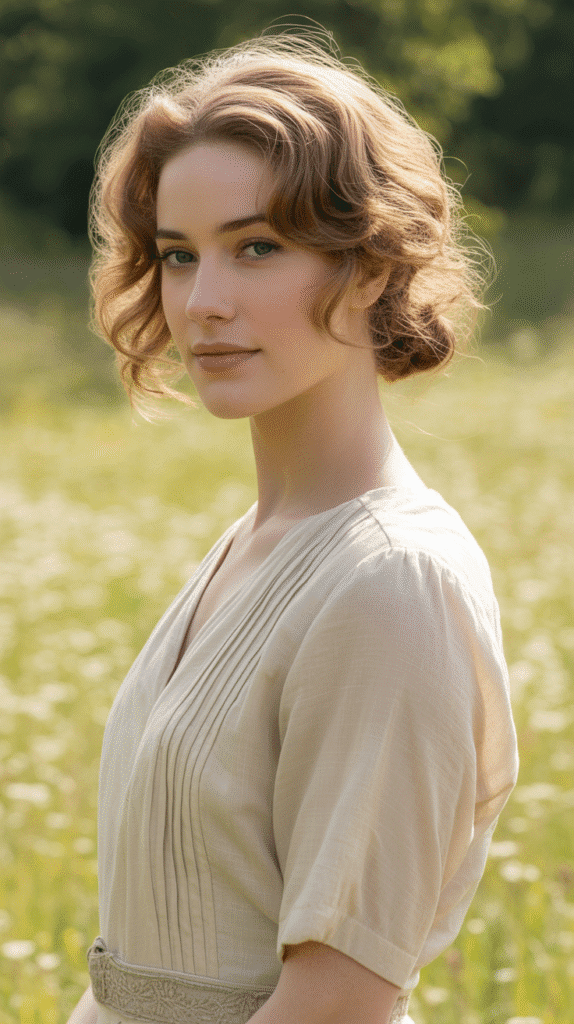
Soft romantic waves created a gentler interpretation of 1930s styling, featuring loose, flowing S-curves without the precise structure of finger waves.
This approachable style worked beautifully for casual daytime wear and informal gatherings.
Creating Loose Wave Texture
- Start with damp hair and apply a light leave-in conditioner or wave cream
- Unlike finger waves, do not use heavy gel or strong setting lotion
- Divide hair into 2-inch sections
- Take each section and twist it loosely around your finger, then pin it to the head in a loose loop
- These loops should be much looser than traditional pin curls
- Alternate the direction of loops to create natural-looking wave patterns
Developing Soft Movement
- Allow hair to air dry or use a diffuser on low heat
- The goal is gentle drying that doesn’t disturb the setting pattern
- Once completely dry, remove pins and shake out the hair gently
- Use your fingers (not a brush) to separate and arrange the waves
- Scrunch sections gently to enhance the wave pattern without flattening it
- Create a side or center part and direct waves to flow naturally from it
- For more definition in certain areas, use a large-barrel curling iron
- Loosely wrap sections around the iron for 3-5 seconds only
- This creates suggestion of waves rather than defined curls
- Apply a small amount of lightweight oil to palms and smooth over the hair surface
- This adds shine and tames frizz while maintaining the soft, touchable texture
- Finish with flexible-hold spray or no product at all for natural movement
- This style should look effortless and romantic rather than structured
24. Pin-Up Style Rolls
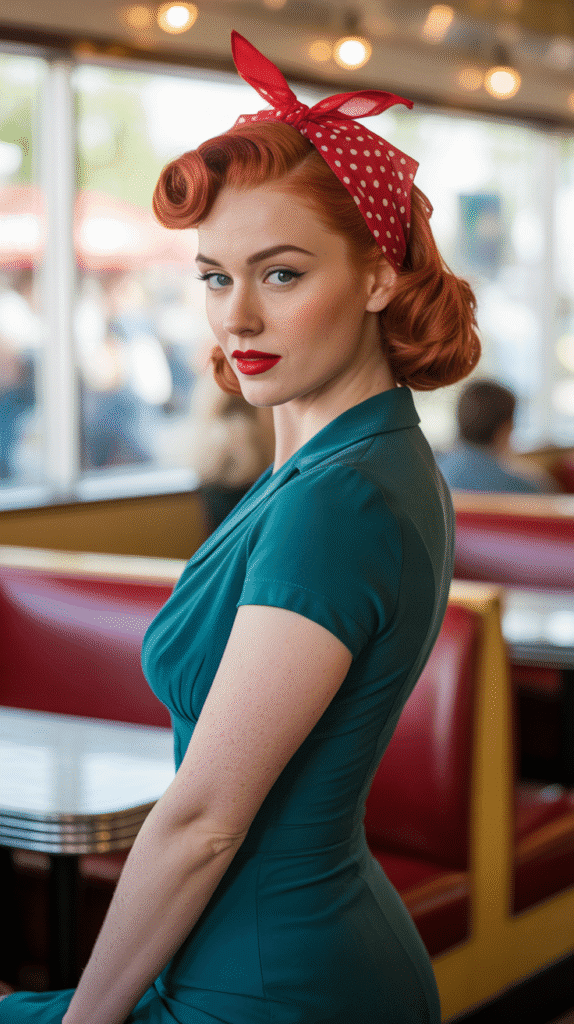
Pin-up style rolls combined victory rolls with curled ends, creating a hybrid style that bridged late 1930s and early 1940s aesthetics.
tis playful yet glamorous look featured rolled sections at the front with the remaining hair styled in curls.
Creating Front Rolls
- Section the front portion of hair from temple to temple, about 3 inches deep
- Divide this section into two equal parts with a center part
- Take one front section and backcomb at the roots for volume
- Smooth the surface while maintaining internal volume
- Roll the section backward toward the crown, creating a tube-shaped roll
- Position the roll slightly to the side of center for asymmetrical interest
- Secure with bobby pins inserted through the roll into the hair beneath
- Repeat with the opposite front section, creating a matching roll
- Alternatively, create one large central roll instead of two separate ones
Styling the Remaining Hair
- With the front rolls secured, focus on the rest of the hair
- For shorter hair, curl the ends under into a pageboy-style curve
- For medium length, create pin curls throughout and brush into soft waves
- For longer hair, form victory rolls on the sides and curl the ends
- Many pin-up variations included ponytails curled at the ends
- Gather hair at crown or mid-head into a ponytail if desired
- Curl the ponytail in sections, creating spiral curls that cascade down
- Alternatively, leave hair loose and create barrel curls throughout
- Add a bandana, scarf, or ribbon tied around the head for authentic pin-up flair
- The bandana typically goes behind the front rolls, tying at the top or side
- Finish with hairspray and adjust curls to frame the face attractively
25. Side Bun with Waves
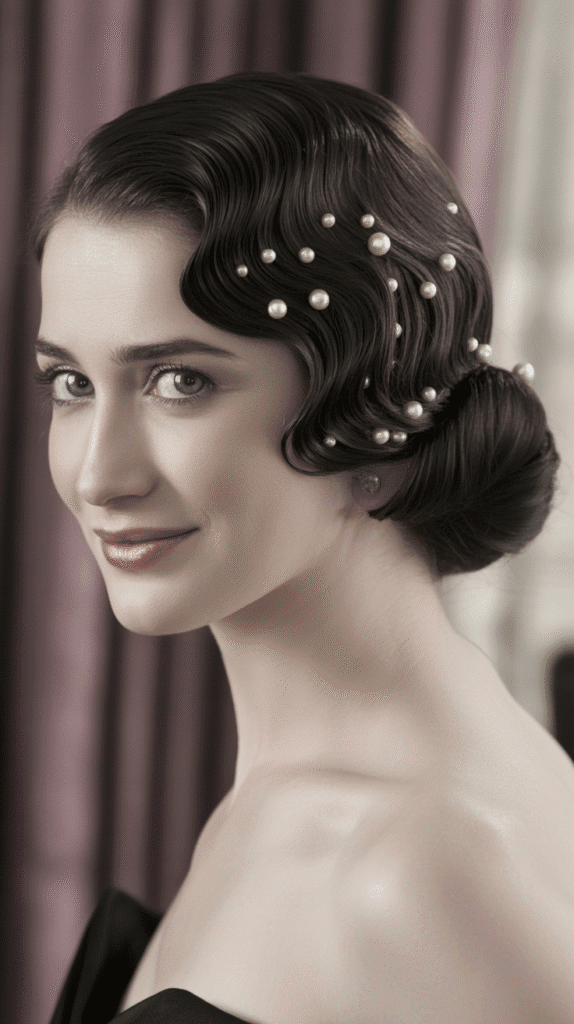
The side bun with waves positioned a polished bun at the side of the head (usually behind and slightly below the ear) while the top sections featured finger waves or smooth styling.
This elegant asymmetrical style was popular for evening events.
Setting the Top Waves
- Create a deep side part on the opposite side from where you’ll position the bun
- Apply setting lotion to damp hair in the top sections
- Create finger waves on the larger side of the part from front to crown
- On the smaller side, smooth the hair sleekly against the head with gel
- Clip the waves and allow them to dry partially
Forming the Side Bun
- Gather all hair from the crown back and sides, directing it to one side of the head
- Position the gathering point behind and slightly below the ear
- Secure with an elastic in a side ponytail
- If top sections are still damp, dry completely before proceeding
- Remove wave clips from the top sections
- Take the ponytail and twist it into a rope
- Wrap the twisted rope into a circular bun shape
- Tuck the ends underneath the bun
- Secure the bun with bobby pins placed around its perimeter and through its center
- For a fuller bun, use a hair donut or rolled sock as padding
- Place the donut over the elastic and spread hair around it
- Tuck ends underneath and pin securely
- Ensure the finger waves on top remain smooth and defined
- The contrast between sculptural waves and neat bun creates sophisticated elegance
- Add a decorative hair comb or jeweled pins to the bun for embellishment
- Finish with hairspray, focusing on the wave sections
26. Curled Fringe with Smooth Back
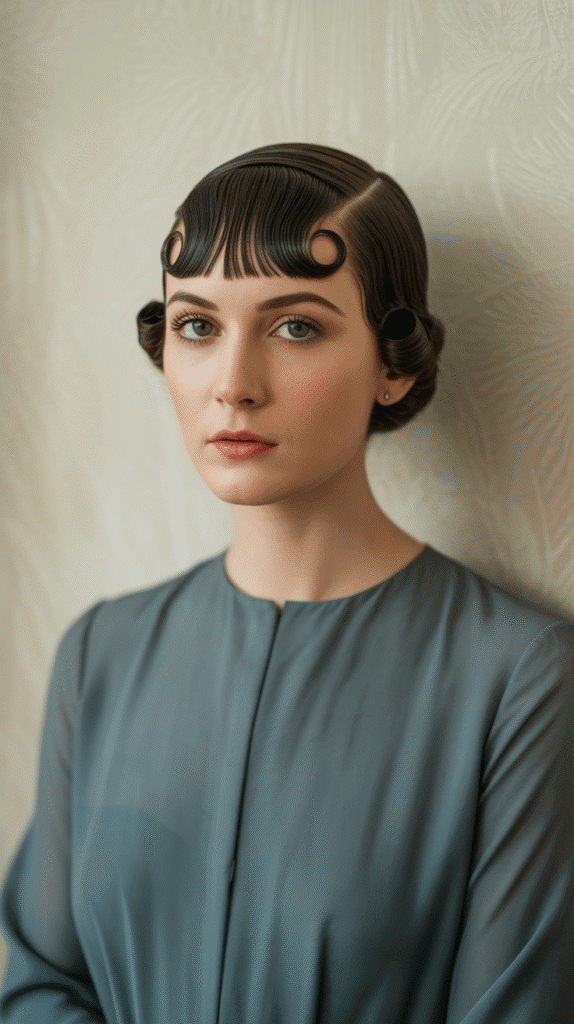
The curled fringe style featured bangs curled into small ringlets while the rest of the hair was smoothed back into a low style, creating interesting textural contrast.
This playful yet polished look added personality to otherwise conservative styling.
Creating the Curled Fringe
- Section off the bangs area in a horizontal line from temple to temple about 2 inches deep
- Clip away the remaining hair
- Further divide the bang section into 1-inch vertical subsections
- Apply setting lotion or curl cream to the bang sections
- Take each subsection and wrap tightly around a small curling iron (3/4 inch barrel)
Styling the Smooth Back
- Hold each curl for 8-10 seconds to create tight ringlets
- Release into your hand and pin the curl while it cools
- Continue until all bang sections are curled
- Allow curls to cool completely before touching them
- For the remaining hair, apply smoothing cream throughout
- Brush everything straight back from the hairline using firm, smooth strokes
- Gather the hair at the nape into a low ponytail, bun, or tuck
- Ensure the sides and crown are completely smooth without bumps
- Use gel or pomade on any flyaways or baby hairs
- Once the back is secured, return to the bangs
- Remove pins or clips from the cooled curls
- Separate each curl into 2-3 smaller ringlets using your fingers
- Arrange the ringlets across the forehead, allowing them to fall naturally
- Pin some curls to the side if desired for varied positioning
- The contrast between the textured fringe and smooth back creates visual interest
- Apply light hairspray to the curls without making them crunchy
27. Double Crown Twist
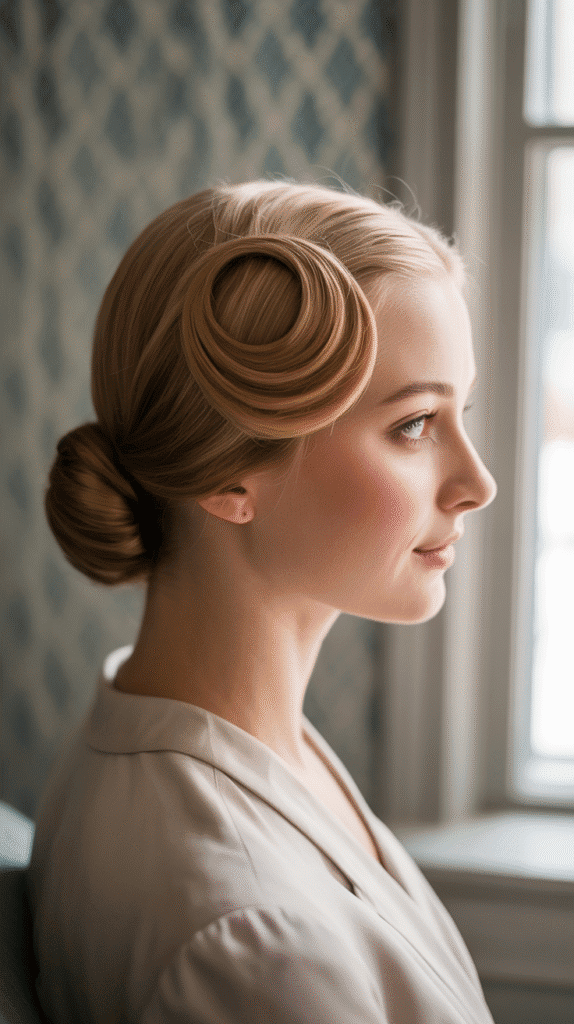
The double crown twist featured two twisted sections meeting at the crown, creating an elegant updo foundation that could be finished in various ways.
This versatile technique worked for both casual and formal occasions depending on the finishing touches.
Creating the Twists
- Start with hair that has some texture from waves or slight curls
- Create a center part from forehead to crown
- Take the front section on one side from the part to the temple
- Divide this section into two strands
- Twist the two strands around each other, rope-braid style
- Twist tightly enough to hold structure but not so tight it causes tension
- Direct the twist backward toward the crown
Meeting at the Crown
- Secure the first twist temporarily at the crown with a clip
- Repeat the twisting process on the opposite side
- Bring the second twist to meet the first at the crown
- Cross the twists over each other, creating an X shape
- Pin both twists securely where they intersect using bobby pins
- Add additional pins along the length of each twist to secure it to the head
- The twists should lie flat against the head, not lifted
- For the remaining hair at the back and sides, you have several options
- Option 1: Gather into a low bun at the nape
- Option 2: Create victory rolls on the sides
- Option 3: Leave down in soft curls or waves
- Option 4: Form a French twist with the remaining hair
- Ensure the twisted sections remain neat and tight throughout the day
- Apply hairspray specifically to the twisted sections for longevity
- This foundational technique can be dressed up with accessories or kept simple
28. Structured Side Waves
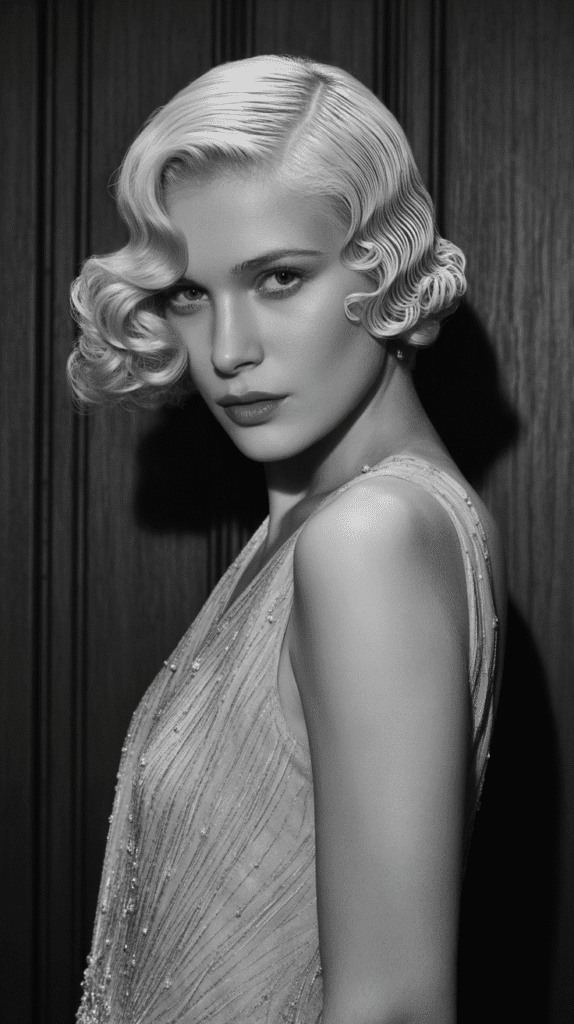
Structured side waves featured all the hair swept dramatically to one side with waves held in rigid, precise formation.
This sophisticated style required strong hold products and was reserved for glamorous evening occasions requiring hair to stay perfect.
Creating Maximum Hold Waves
- Start with damp hair and apply extra-firm hold gel throughout
- Create an extreme side part, positioning it at the far edge of one eyebrow
- On the smaller side, slick hair flat against the head with more gel
- Pin this side completely flat behind the ear with multiple bobby pins
- Focus all attention on the larger side where waves will be formed
Forming Rigid Structures
- Using finger wave technique, create very precise S-curves on the larger side
- Make each wave approximately 1.5 inches from crest to crest
- Press firmly when forming each ridge to create sharp definition
- Use generous amounts of wave clips to hold every millimeter of the wave pattern
- Place clips closer together than normal (every half inch) for maximum control
- Ensure all waves flow horizontally in perfect parallel lines
- The waves should extend from the part line down over the shoulder
- Apply additional gel to the surface of the waves after clipping
- Dry under a hood dryer on medium heat for 1-2 hours
- Do not remove clips until hair is completely dry and has cooled for 30 minutes
- When removing clips, work very carefully to avoid disturbing the wave structure
- Apply firm-hold hairspray immediately after removing clips
- The finished waves should hold their shape rigidly without any movement
- This style creates dramatic, sculptural glamour for formal photographs and events
29. Vintage Ponytail with Rolled Front
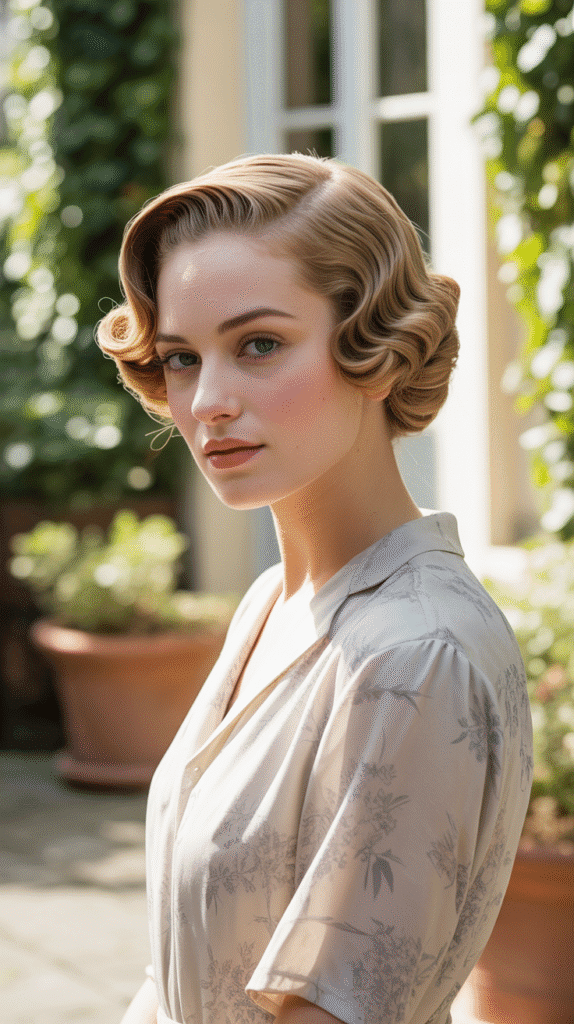
The vintage ponytail combined the casual ease of a ponytail with elegant rolled sections at the front, creating a style that was both practical and fashionable.
This hybrid look worked beautifully for active daytime wear in the late 1930s.
Creating the Front Rolls
- Section off the front portion of hair from temple to temple, about 3-4 inches deep
- Decide whether to create a central pompadour or side victory rolls
- For pompadour: backcomb the front section, smooth the surface, and roll backward
- Pin the pompadour securely at the crown where it meets the remaining hair
- For side rolls: divide the front section in half and create victory rolls on each side
- Each roll should be positioned above the temples framing the face
Forming the Ponytail
- Gather all remaining hair from crown, sides, and back
- Position the ponytail at crown level for a perky, youthful appearance
- Secure with a fabric-covered elastic that matches your hair color
- Smooth any bumps at the sides and back using a brush and gel
- Take a small section from the ponytail and wrap it around the elastic
- Secure the wrapped section with a bobby pin to hide the elastic
- For authentic 1930s styling, curl the ponytail hair in sections
- Use a curling iron to create 1-inch curls throughout the ponytail length
- Allow curls to cool, then gently separate them with fingers
- Arrange the curls to cascade downward in an organized, bouncy fountain
- Alternatively, create soft waves in the ponytail instead of curls
- Ensure the front rolls remain prominent and well-defined
- The contrast between structured front and flowing ponytail creates youthful charm
- Finish with flexible hairspray that allows the ponytail to move naturally
30. Hollywood Glamour Waves
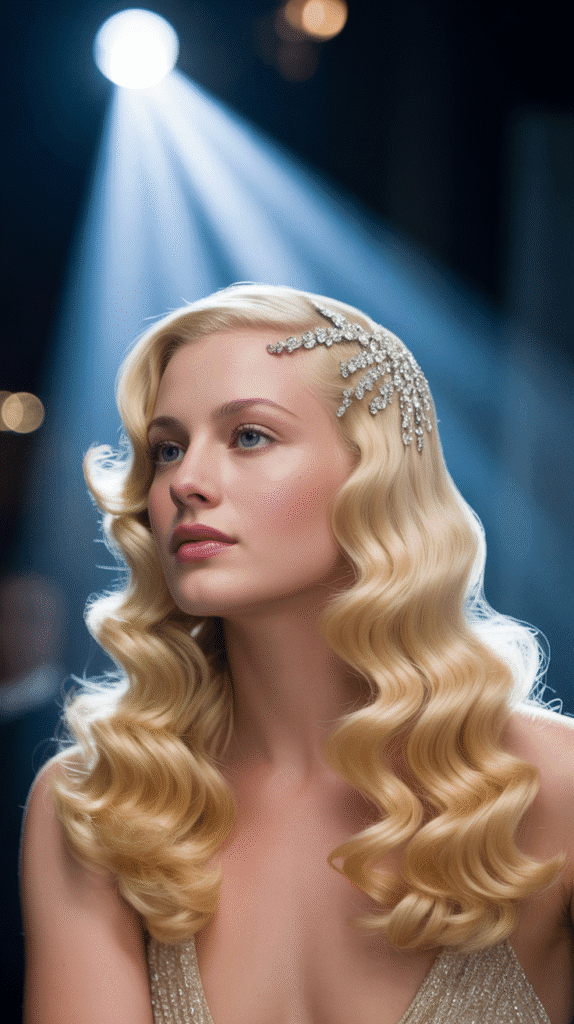
Hollywood glamour waves represented the pinnacle of 1930s hairstyling, combining multiple techniques into one show-stopping style with perfect finger waves, smooth sections, and strategically placed curls.
This red-carpet look required advanced skills and patience but delivered breathtaking results.
Planning the Complete Style
- This style combines finger waves, smooth sections, pin curls, and Marcel waves in one cohesive design
- Sketch a mental plan of which sections will feature which techniques
- Typically: finger waves on top, smooth sides, curled ends
- Start with completely clean, conditioned hair that’s been blown smooth
- Apply setting lotion to the entire head, varying the strength by section
Executing Multiple Techniques
- Begin with finger waves on the top sections from front to crown
- Create 3-4 perfect waves on the larger side of a deep side part
- Clip these waves securely and ensure they’re perfectly symmetrical
- On the smaller side of the part, create a sleek, smooth section with gel
- This smooth section should contrast with the waved section
- At the crown area, transition from finger waves to smooth pin curls
- These pin curls will be brushed out to create soft volume
- On the back and side sections, create pin curls in a brick-lay pattern
- At the very ends (last 3-4 inches), use smaller barrel curls for definition
- Dry the entire style thoroughly under a hood dryer for at least one hour
- Allow hair to cool completely before removing any clips or pins
- Remove finger wave clips first, leaving those waves untouched
- Remove pins from the back and brush through gently to create waves
- The ends should remain as defined curls
- Blend all sections together seamlessly, ensuring smooth transitions
- Apply shine serum for Hollywood luminosity
- Position strategic sections over the shoulder for asymmetrical drama
- Add a jeweled headpiece, hair comb, or vintage clip for ultimate glamour
- Apply firm-hold hairspray in sections, building up gradual layers of hold
- This masterpiece style showcases all 1930s techniques in one stunning presentation
Essential Tools and Products for 1930s Hairstyles
To successfully recreate authentic 1930s hairstyles, having the right tools and products makes all the difference. Here’s a comprehensive guide to what you’ll need:
Tips for Maintaining 1930s Hairstyles
- Protect your style overnight by wrapping hair in a silk or satin scarf to prevent frizz and maintain wave patterns
- Touch up finger waves between washes by applying water mixed with setting lotion to specific sections and re-clipping
- Refresh curls by lightly misting with water and re-curling just the sections that have fallen
- Use dry shampoo at the roots only to extend time between washes without disrupting the style
- Sleep on a silk or satin pillowcase to reduce friction that can destroy waves and curls
- For long-lasting hold, always ensure hair is completely dry before removing any clips or pins
- Reapply hairspray daily to maintain structure, focusing on areas that tend to fall first
- Invest in quality vintage-inspired products formulated specifically for retro styling techniques
Adapting 1930s Styles for Modern Life
While authentic 1930s hairstyles are beautiful, they often required daily setting and significant time investment. Here are ways to adapt these vintage looks for contemporary lifestyles:
- Use modern heat tools like curling irons and flat irons to achieve similar effects more quickly than wet-setting methods
- Create faux finger waves with a flat iron by creating S-bends in the hair and pinning until cool
- Incorporate vintage elements like victory rolls or rolled bangs into otherwise modern hairstyles
- Use strong-hold products that set faster than traditional setting lotions used in the 1930s
- Consider getting a body wave or perm to add texture that makes vintage styling easier
- Focus on signature elements like deep side parts and smooth sections rather than recreating entire complex styles
- Embrace hair extensions or clip-ins to add length or volume needed for certain vintage styles
- Practice techniques on weekends when you have more time, then simplify for weekday wear
Conclusion
Mastering these 30 Step-by-Step 1930s Hairstyles Tutorial for a Retro Makeover opens up a world of timeless elegance and old Hollywood glamour that remains stunning nearly a century later.
From the sculptural precision of finger waves to the romantic softness of the Gibson tuck, each style captures the sophistication and artistry that defined Depression-era beauty despite economic hardships.
The techniques presented in this guide provide you with a comprehensive toolkit for recreating authentic vintage looks, whether you’re preparing for a themed event, vintage wedding, period film production, or simply exploring your passion for retro aesthetics.
Remember that perfecting these styles requires practice and patience—the women of the 1930s spent significant time on their hair, viewing it as an art form rather than a rushed routine.
As you experiment with different techniques, you’ll discover which styles suit your face shape, hair texture, and personal aesthetic while developing the skills that made 1930s hairstyling legendary.
The beauty of these vintage techniques lies not only in their visual impact but also in their connection to a glamorous era when hair was styled with intention, creativity, and remarkable attention to detail.
Whether you choose to embrace these styles fully or incorporate vintage elements into modern looks, the elegance of 1930s hairstyling continues to inspire and captivate, proving that true style is indeed timeless.